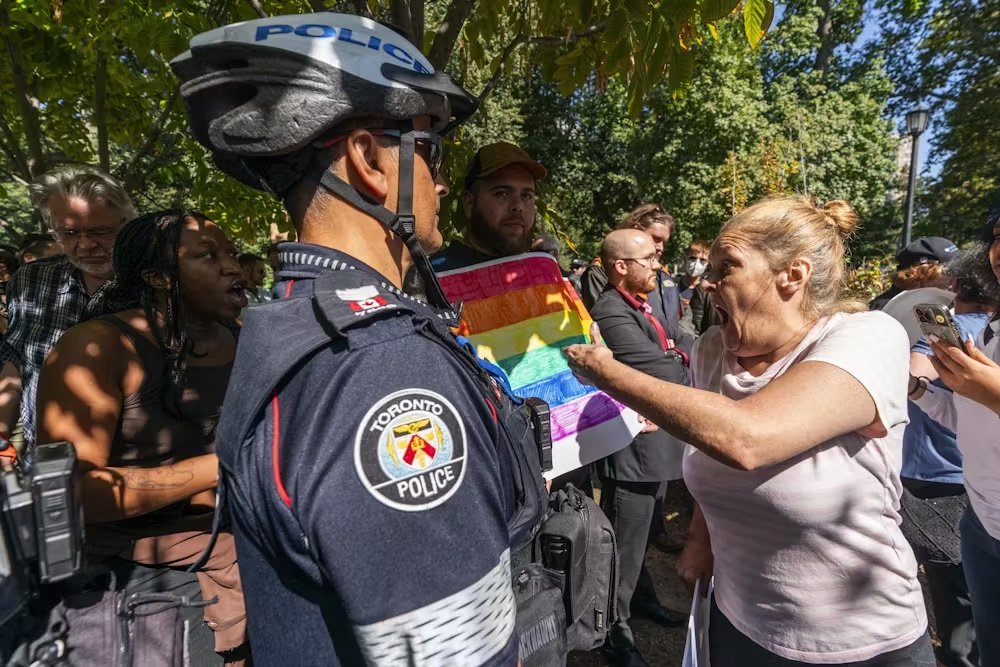On the Importance of Safe Environments: Examining Debates on Schools and 2SLGBTQ+ Inclusivity
Image By: The Conversation
On September 20th, 2023, a protest and a counter-protest happened on St. Catherine Street in downtown Montreal. The protest was led by a movement called 1 Million March 4 Children, which advocates “for the elimination of Sexual Orientation and Gender Identity curriculum, pronouns, gender ideology and mixed bathrooms in schools.” The movement encouraged protests across Canada, throughout many major cities. Counter-protests arose in response to these protests, including one in Montreal.
While the objective of the protest was to change the educational system’s approach to “gender ideology”, the rhetoric reflected anti-2SLGBTQ+ sentiments, which invoked strong responses from all members of society. Celeste Trianon, one of the organisers of the Montreal counter-protest, emphasised that “trans people exist in society, and they deserve inclusion, just like everyone else.” This article will focus on the debate regarding gender ideology within the school setting.
Firstly, what is gender-affirming care? CBC explains that gender-affirming care is an umbrella term: “an approach to health care that supports a patient’s gender expression.” It consists of non-medical aspects like utilising an individual’s preferred pronouns and name and medical aspects like therapy and counselling, prescribing medicine, and surgical procedures. In the school setting, pro-2SLGBTQ+ groups advocate for creating an anti-bias education where “teachers [can] adjust their approaches to support all the children in their care.” This predominately consists of empathetically acknowledging LGBTQ families to create “an inclusive, sensitive environment for all children.” To achieve the goal of creating an inclusive environment, researchers Bre Evans-Santiago and Miranda Lin recommend implementing LGBTQ components in classroom settings by using inclusive literature, storytelling, and inclusive projects and documents. Research demonstrates that these efforts from educators to increase inclusivity can assist children in understanding that “there is nothing wrong with differences among people'' (Derman-Sparks & Edwards 2010, as cited by Evans-Santiago and Lin). It is important to note that an inclusive environment is also encouraged in light of the disproportionate injustice and discrimination that 2SLGBTQ+ students face in school and to possibly remedy it.
The protestors aimed to establish that “there is something wrong with differences among people.” They argued that schools have a pervasive influence and they should not use their influence to spread a message which contradicts the wishes of the parents. Interconnected with this issue of governmental influence on children's education is the fear that there is a causal relationship between “openness and acceptance” to “people identify[ing] as LGBT.” To parents who disagree with the 2SLGBTQ+’s message, the prospect of an inclusive educational system that leads to a greater amount of participation in the 2SLGBTQ+ community may be concerning.
In Canada, the government of New Brunswick has recently commented on this matter by amending Policy 713. The policy, which was implemented in 2020, set out to create “minimum requirements for school districts and public schools to create a safe, welcoming, inclusive, and affirming school environment for all students, families, and allies who identify or are perceived as LGBTQI2S+.” Its revision in June of 2023 sparked controversy, as the policy, which formerly mandated the use of preferred pronouns and first names, was amended to require parental consent in most cases for students younger than 16 in order to use the student’s preferred name and pronouns. Parental consent is not a necessary condition and can be achieved through communication with the school psychologist or social worker, though the precise conditions are not explicitly stated in the document. Considering – however, in Anglophone school districts with one school psychologist for 10000 students and 84% vacancies in school psychologist positions – the policy seems to be sending an alternative message: a recognition of parental authority over students.
While not written in policy, Bill Hogan, the Minister of Education in New Brunswick, claimed in an interview that the bill forbids teachers from using the preferred pronouns or first names of students under sixteen years of age without explicit parental consent. In conversation, Pierre Pollievre dissented from Justin Trudeau, “butt out and let provinces run schools and let parents raise kids.” Justin Trudeau condemned New Brunswick’s policy change. A similar policy to that of New Brunswick was adopted by Saskatchewan as well.
In this context of opposing political views of some parents and the government, Michael Sandel points out that it is essential to recognize the influence of beliefs and values on these political views. Political views are not shaped from scratch; rather, they reflect religious beliefs, norms, values, and various other beliefs linked with other issues. For example, the Pew Research group found that among individuals unaffiliated with a religion, only about 25% believe homosexuality should be discouraged. Meanwhile, among people that identify themselves as religious – from 34% represented by Catholics, up to 70% represented by Evangelical Protestants – believe that homosexuality should be discouraged. Sandel comments that when approaching these issues, individuals must recognize that political views are not valueless and are concerned with conceptions of a good life. All sides in the debate argue that they have a better outlook on what a good life is supported by their various beliefs.
The two confrontations are between parental rights and governmental rights and pro and con arguments toward 2SLGBTQ+ communities. These confrontations are based on political views, which themselves are based on beliefs and values. Recognizing the sources of these political views is important. Recognizing that these different outlooks are based on conceptions of good lives is important. However, as Kennedy says, “Every child, every student, has a right to a safe and inclusive environment.” In this issue-linked case, however, children’s rights to safety and inclusivity are paramount, even if they may go against conceptions of the good life held by parents. Human rights of children must be recognized.

